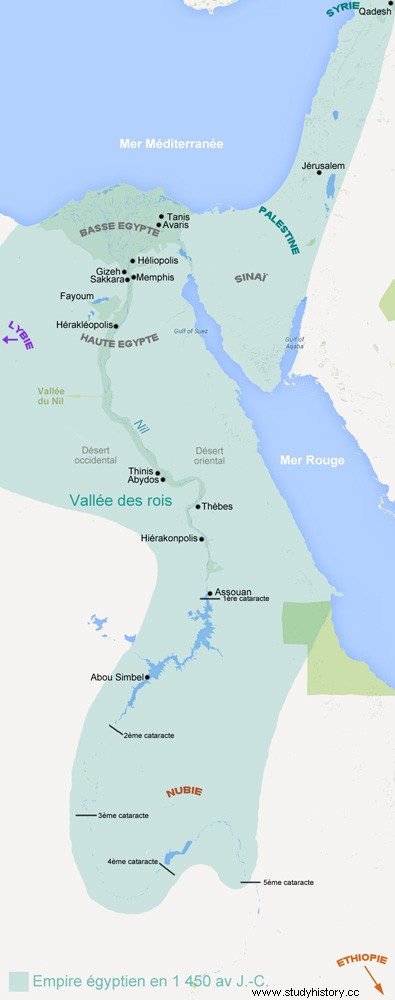
FROM THE XVIIITH TO THE XXTH DYNASTY:
The pharaohs of the New Kingdom usher in a period of prosperity unprecedented. They are elite soldiers and put the military first. They secure borders and strengthen diplomatic ties with their neighbours. They invade the surrounding regions and build a vast empire .
AROUND 1530 TO 1520 BC. AD
Reign of Thutmose I:
It opens the import to the bronze and wood and begins to conquer a vast empire. He led brilliant military campaigns in Nubia to the banks of the Euphrates, including part of Canaan in Mesopotamia . Egypt becomes again, as during the Middle Kingdom , a rich kingdom feared by all neighboring peoples.
Tombs of the Valley of the Kings:
During the New Kingdom the pharaohs are buried in tombs excavated in the rocky basement of a secret valley, the valley of the kings . Although concealed, almost all the tombs were looted, except for that of Tutankhamun . The oldest known on the site is that of Thoutmosis I , and from Thoutmosis III , with the exception of Akhenaton , all the pharaohs of the 18th, 19th and 20th dynasties are buried there. The last known tomb is that of Ramesses XI .
TOWARDS 1505 B.C. AD
Pharaoh Hatshepsut ascends the throne:
On the death of Thutmose I, his son Thoutmose II ascends the throne. But probably in fragile health, he died of illness soon after. Hatshepsut, his wife and half-sister, finds herself a widow with her son-in-law Thoutmosis III (which Thutmose II had by a secondary wife). Thutmose III being only 4 years old, it is Hashepsut who ascends the throne takes his place. To establish her power and her authority, she proclaims herself “carnal daughter of Amon” and must renounce the attributes of her femininity by representing herself with a flat chest, wearing the false beard and the masculine clothes of the pharaohs. It leads a policy of major works, organizes trade and economic relations with foreign countries, builds a pair of colossal obelisks and a chapel in Karnak. His authority abroad is respected, none of his father's conquests have been lost, and peace seems to reign in the territories occupied by the Egyptians. The most famous journey of his reign was the expedition to the land of Punt, located on the borders of the Red Sea and Black Africa, which enabled him to bring back the incense, perfumes and herbs necessary for the worship of 'Has my. Hatshepsut also had his tomb and a mortuary temple of rare elegance built in Deir el-Bahari. The bas-reliefs illustrate the great moments of his reign and in particular his expedition to Punt. Many historians have given the Queen the image of a usurper devoured by ambition who would have stolen a power that did not belong to her. Outside, Hatshepsut already held power before her coronation and her accession to the throne does not seem to have aroused any opposition. According to the great Larousse of world history , to assert her rights, Hatshepsut would have married her son-in-law Thutmose III who would have reigned at her side as co-manager. But Hatshepsut would have ruled the country according to her own will, keeping her husband away.
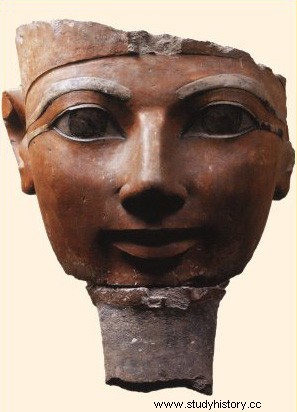
CIRCA 1493 TO 1450 BC. AD
Thutmose III ascends the throne:
When Hatshepsut dies, Thutmose III ascends the throne. He is already an elite soldier and he is the greatest pharaoh warrior that ancient Egypt has known. Endowed with rare will and tenacity, he leads his army 18 times in war and conquers a vast empire which extends from Syria-Palestine to the north, at the 5th cataract of the Nile in Nubia South. People from all over the empire come to the court of the pharaoh to bring merchandise for sale and lavish gifts . These gifts are a kind of tax or tribute , which the conquered peoples must pay. Some foreign rulers even send their daughters to be married off to the pharaoh, who already has many wives. A flood of wealth is pouring into Egypt and the Egyptian Empire is at its peak . Slaves, wood, precious metals are used for royal constructions. Exhausted by two centuries of war, Egyptian society is changing and the middle class, formed during the Middle Kingdom, is disappearing. The high dignitaries are more and more numerous and become richer every day by taking advantage of the conquests. The court at that time led the most luxurious life that Egypt had known. Culture shines, the arts become extremely refined, the temples of Karnak and Luxor are enlarged, the tombs of the Valley of the Kings become more and more sumptuous and many new places of worship are erected, in particular the temples of Abu Simbel. Egypt lives in unprecedented prosperity and luxury.
ABOUT 1,450 TO 1,372 BC. AD
Military parades:
The Pharaohs Amenophis II, eldest son of Thutmose III, then Thutmose IV and Amenophis III, did not enlarge the immense Egyptian Empire already conquered, but contented themselves with making military parades intended to intimidate peoples who wanted to rebel. However, the army is growing in importance and military officers are among the people the country can count on. To get help, the pharaohs surround themselves with 3 important people:a first vizier for Lower Egypt, a second for Upper Egypt and a viceroy for Nubia.
The cult of Amun:
The XVIII dynasty made Amun, elevated to the rank of the great Egyptian gods by Mentuhotep I during the Middle Kingdom, the supreme god of Egypt delivered from the Hyksos. Amon means “the hidden god” and is found in the name of many pharaohs . Assimilating the characters of other deities and especially of Rê , his name becomes Amon-rê . It becomes universal throughout Egypt and its temple at Karnak is the largest in the country. The clergy of Amon benefited from many gifts and continued to expand their influence and their landed domains, which made them a dangerous power for the pharaoh.
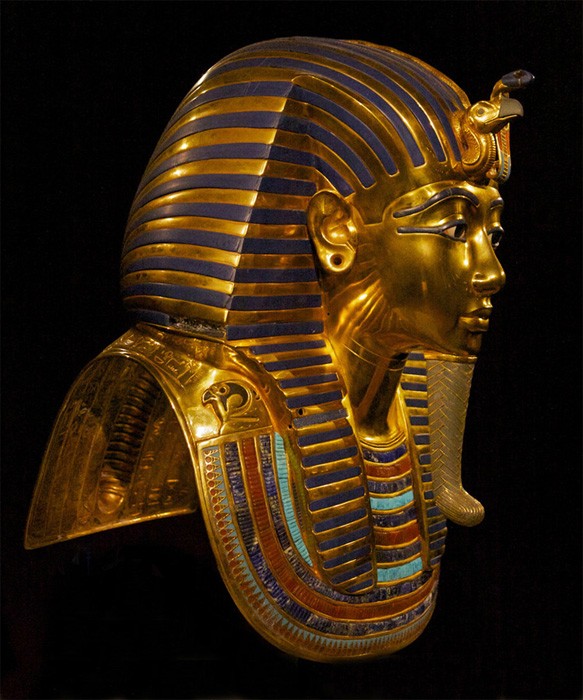
CIRCA 1,372 TO 1,354 BC. AD
Reign of Amenophis IV:
Son of Amenhotep III and his wife Queen Tiy, Amenhotep IV, whose name means “Amun-is-satisfied”, was brought up in a refined atmosphere, where people were more concerned with aesthetics and religious questions. than war and hunting. He marries an exceptional queen, Nefertiti “La-belle-est-venue” whose disappearance remains a mystery. The stability of the New Kingdom is threatened when Amenhophis IV decides to impose a series of radical and chaotic reforms. He reforms religion imposing Aton , the solar disk, as the unique and supreme deity . For him, as for Nefertiti , the uniqueness of the divine, of which the king has a mystical experience, cannot be represented, but simply symbolized. He creates the city of Akhet-Aton (which means “The horizon-of-the-sun-disc” – currently Tell el-Amarna) and made it the new capital, with its superb palaces and a huge temple dedicated to Aten. He also changes his name to Akhenaton which means “Pleasant-a-Aton”. He turns a deaf ear to foreign affairs because he is completely absorbed in his new religion. After his death, the Egyptians reestablished the traditional deities and the cult of Aten was quickly abandoned.
CIRCA 1335 TO 1327 BC. AD
Reign of Tutankhamun:
Tutankhamun, son of Akhenaten and according to recent studies, son of the latter's own sister, died at the age of 19 after a reign of 8 or 9 years. He was buried in the Valley of the Kings and owes his fame to the discovery of his tomb by the British archaeologist Howard Carter November 4, 1922 and the fabulous treasure it conceals. His head was covered with a magnificent solid gold mask and his mummy rested in 3 coffins, 1 of which was also solid gold, all nested in a huge stone sarcophagus. The notoriety of the discovery increased thanks to a legend taken up by the press of the time and reporting a "curse of the pharaoh" .
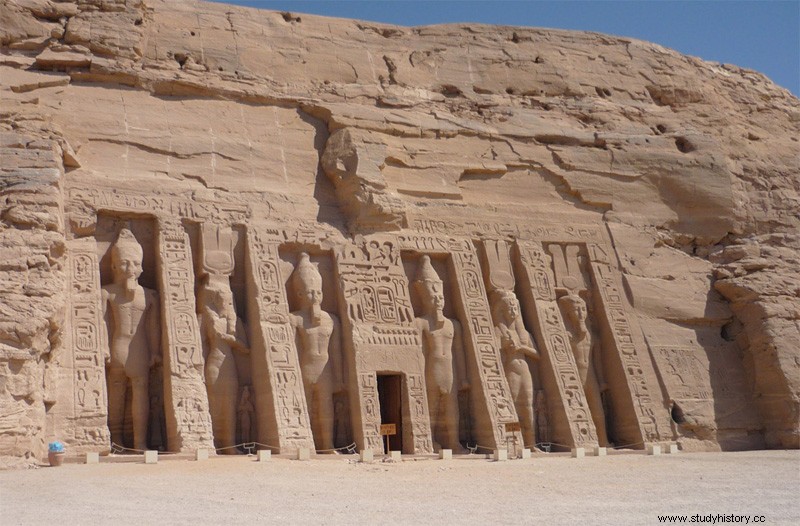
ABOUT 1,279 B.C. AD
Ramesses II ascends the throne:
Rameses II begets more children than any other pharaoh in the history of Egypt . It establishes a long period of peace and covers the country with superb monuments (temples, statues, obelisks, etc.). He had the small temple of Abu Simbel dedicated to his wife Queen Nefertari , represented as the goddess Hathor. On each side of the door, the statue of the sovereign is framed by two statues of Ramses II.
ABOUT 1,274 B.C. AD
Battle of Kadesh:
Rameses II is a daring military leader (he was already chief of the armies at the age of 10) and he fights the Hittites during the terrible and famous battle of Qadesh, none of which will emerge victorious. This battle is traced on the walls of Abou-Simbel .
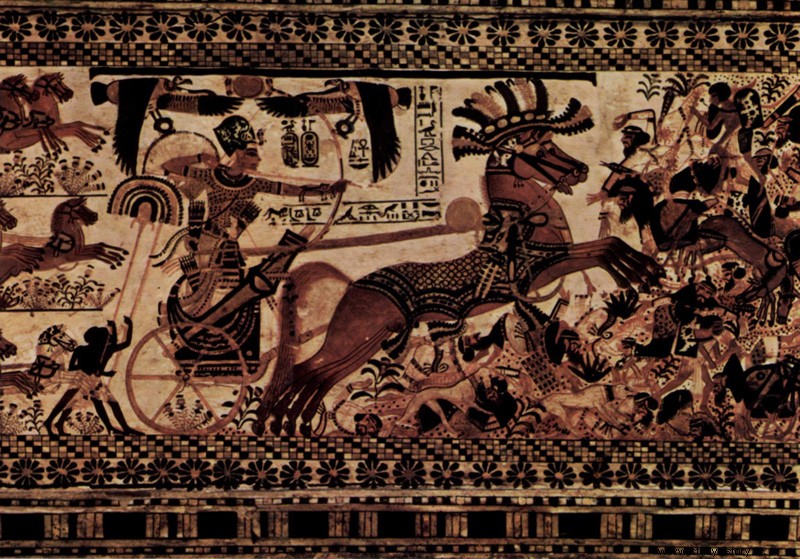
ABOUT 1,259 B.C. AD
Peace Treaty:
Rameses II and the Hittite King Hattousil III sign the first known international peace treaty. Ramses II marries a Hittite princess.
AROUND 1,190 B.C. AD
Sea Peoples attack Egypt:
Ramesses III defends Egypt and triumphs against the Sea Peoples who scatter around the Mediterranean.
CIRCA 1186 TO 1154 BC. AD
Reign of Ramses III:
Ramesses III will be the last great ruler of the New Empire Egyptian. The wealth of Egypt makes it a target of choice and the country also suffers from the invasion of the Libyans .
End of the New Kingdom:
At death of Ramesses III the Egyptian Empire is weakening and is gradually sinking into a serious crisis economy, a period of corruption and disorders civilians. The tombs in the Valley of the Kings are looted. Egypt finally loses control of Syria and Palestine .
Dynasties and list of pharaohs during the New Kingdom
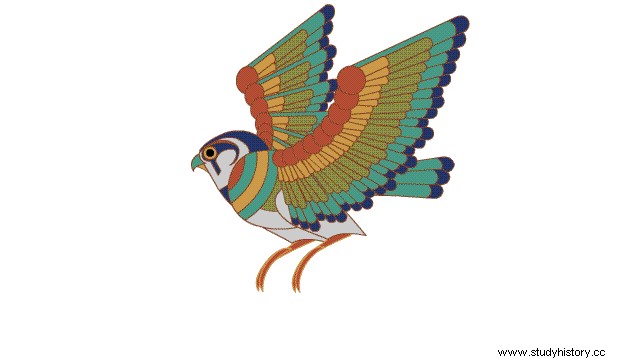
XVIIIth dynasty: (1580 to 1314 BC) Ahmose, Thutmose I, Thutmose II, Hatshepsut, Thutmose III, Amenophis II, Thutmose IV, Amenophis III (temple at Louqsor), Akhenaten or Amenophis IV (Tell el-Amarna ), Semenkharê, then Tutankhamun, Ay and Horemheb reign simultaneously.
XIXth dynasty: (1314 to 1200 BC) Ramses or Ramesses I, Sethi or Seti I, Ramses II (Abou-Simbel), Mineptah or Minephtah, Seti II.
XXth dynasty: (1200 to 1085 BC) Sethnakht (Medinet Habou), Ramses III, Ramses IV, Ramses V, Ramses VI, Ramses VII, Ramses VIII, Ramses IX, Ramses X, Ramses XI.
Notes regarding dates from various sources :On wikipedia, according to Manetho and various other sources on the internet, Thutmosis I would have reigned from 1504 to 1492 BC. AD, Hatshepsut ascended to the throne in 1492 BC. AD and Thoutmosis III in 1458 BC. J.-C. Hors, other sources such as those of the great Larousse of world history and a book on Egypt brought from the country, claim that Thutmosis I would have reigned from 1530 to 1520, that Hatshepsut ascended the throne from 1505 to 1493 BC. AD and Thoutmosis III from 1493 to 1450 BC. It is these second data that I transmit here.
Personal notes :This is Akhenaton which was the first to impose the veneration of one and only God (First monotheistic religion).
Learn more about the Hittites, the Sea Peoples and the Middle East during antiquity.
